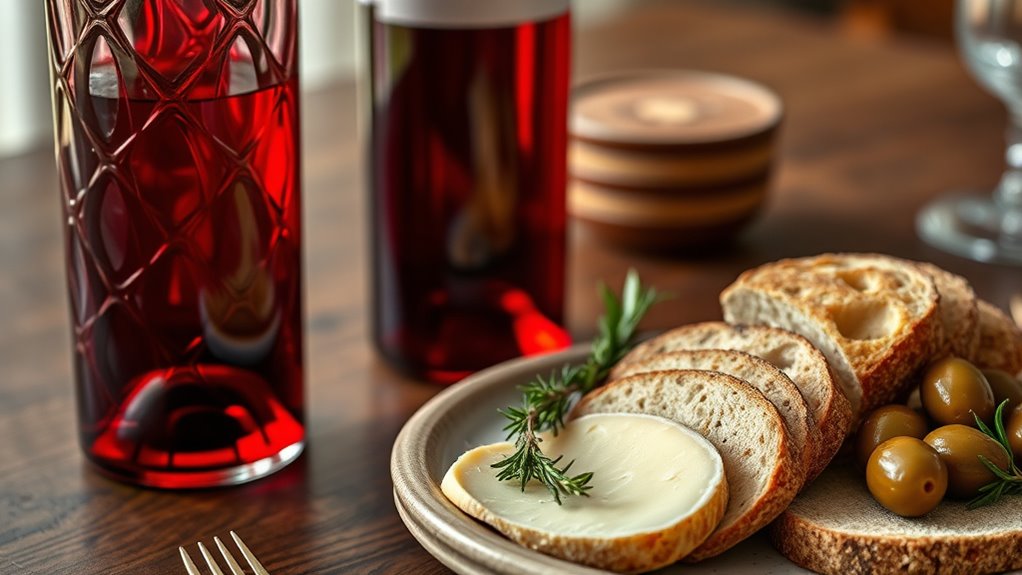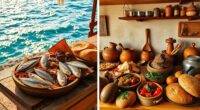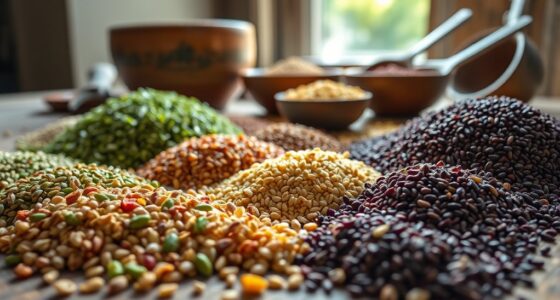To pair Sardinian wines with food, match whites like Vermentino with seafood, salads, and lighter dishes to highlight their citrus and floral tones. For reds like Cannonau, choose hearty meats such as lamb, pork, or game, which complement their bold, spicy character. Light whites like Nuragus go well with subtle cheeses and seafood. Remember to serve whites slightly chilled and reds at a comfortable temperature. Keep exploring to uncover more pairing tips that bring out the best in Sardinian wines.
Key Takeaways
- Match white wines like Vermentino with seafood and grilled fish to highlight freshness and citrus notes.
- Pair bold red Cannonau with hearty dishes such as grilled lamb, roasted pork, or game to balance tannins and spice.
- Use regional cheeses like pecorino with wines like Semidano or aged Cannonau for complementary flavor contrasts.
- Serve whites at 45-55°F for crispness and reds at 55-60°F to enhance aroma and complexity.
- Incorporate native ingredients like bottarga and Pecorino to create authentic and innovative wine and food pairings.
Understanding Sardinian White Wines and Their Food Matches

Sardinian white wines offer a diverse range of flavors and aromas that make them excellent companions to local cuisine. Vermentino stands out with its crisp, floral profile, featuring citrus and green apple notes, making it perfect with seafood like grilled fish or seafood salads. Vernaccia di Oristano is a sweet, fortified wine with honey, dried fruit, and caramel, ideal alongside desserts or cheeses. Semidano offers hints of white flowers and hay, pairing well with medium-aged pecorino or sheep’s milk cheeses. Nuragus has distinctive, native notes and pairs wonderfully with light, herbaceous dishes. Malvasia Bianca, aromatic and structured, complements a variety of Italian dishes, especially those with herbal flavors. These wines showcase Sardinia’s rich terroir and cultural heritage. Sardinia’s white grape varieties dominate in central and northern regions, contributing to the island’s unique wine personality. Additionally, understanding the local winemaking techniques can deepen appreciation for these distinctive wines.
Exploring Sardinian Red Wines and Ideal Pairings
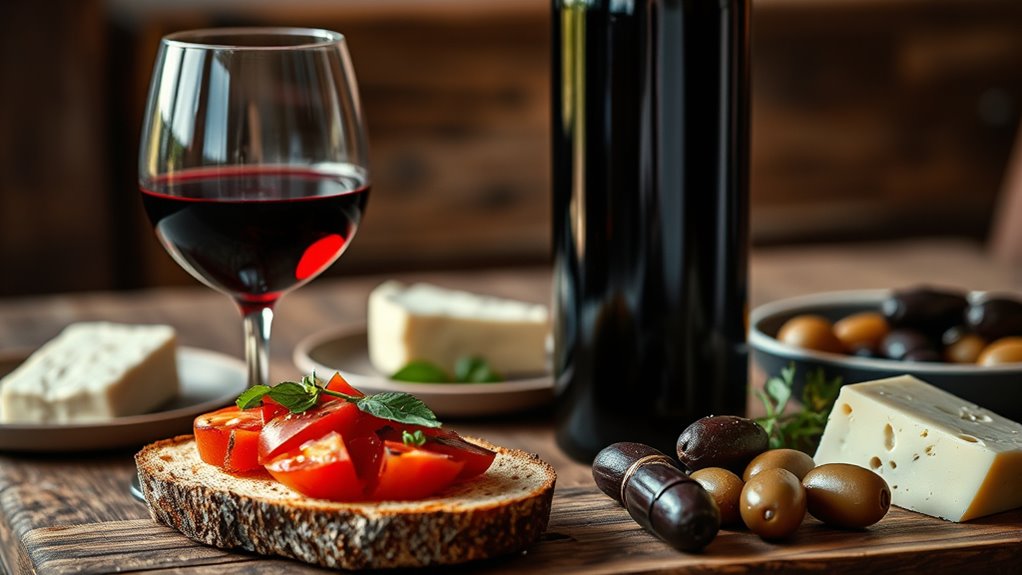
Among Sardinia’s red wines, Cannonau di Sardegna stands out as the region’s flagship, known for its bold character and high alcohol content. Its dark fruit, spice, and herbal flavors make it perfect for hearty dishes. Pair it with grilled lamb, roasted pork, or game to balance tannins and alcohol. Sardinian spicy sausages and stews also enhance its peppery notes, while aged pecorino complements its fruitiness. Dishes with Mediterranean herbs, olives, or tomato sauces echo its aromas. Incorporating mindset strategies such as confidence in pairing choices can elevate your culinary experience.
Regional Dishes and Their Perfect Wine Companions
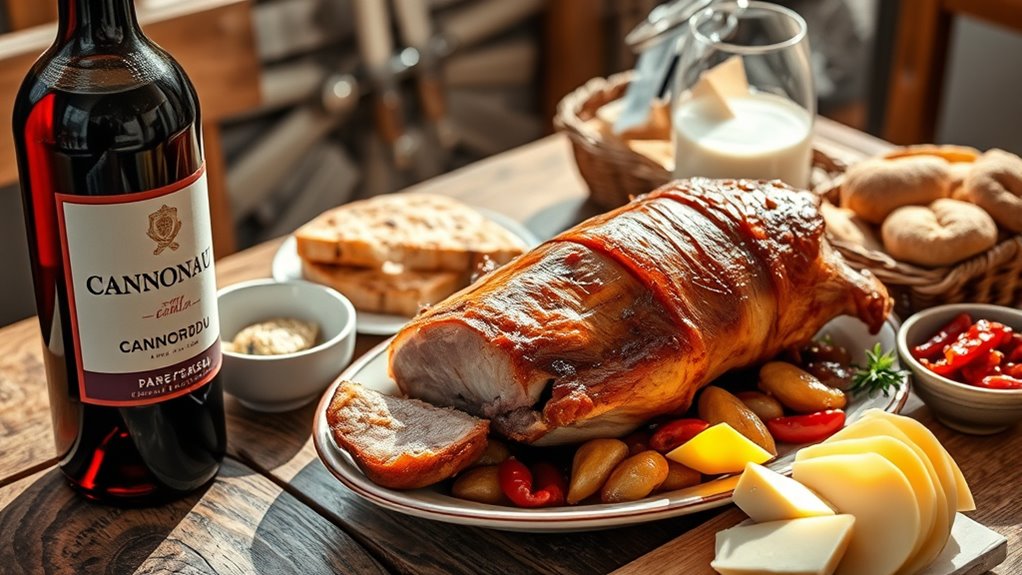
You’ll find that Sardinian seafood dishes shine when paired with Vermentino di Sardegna, thanks to its bright acidity and citrus notes. For hearty roasted meats, wines like Semidano and Torbato complement the earthy flavors without overpowering them. When enjoying local cheeses and breads, Nuragus offers a delicate balance, enhancing their subtle, creamy qualities. Environmental and cultural factors such as the island’s climate and traditional practices play a significant role in shaping the vibrant profiles of these wines, making them ideal companions for regional dishes.
Seafood and Vermentino
Pairing Vermentino with seafood creates a harmonious balance that highlights the fresh flavors of both. Its crisp acidity and bright citrus notes—grapefruit, lime, lemon—cut through the richness of grilled fish or seafood stews. The wine’s aromatic profile, with hints of pear, white peach, and sea breeze, complements shellfish and raw preparations like crudo or carpaccio, enhancing their delicate textures. Vermentino’s minerality and saline finish mirror the sea’s briny character, especially in regions like Gallura and La Maddalena. Serving it at 10–12°C in tulip glasses amplifies its floral and citrus aromas, elevating your seafood experience. Its moderate acidity and subtle bitterness balance oilier seafood, making it a versatile, invigorating companion for Sardinian coastal dishes. Vermentino’s ability to reflect the terroir further enhances its pairing with regional seafood specialties, creating a truly authentic taste experience. Additionally, its food and wine pairing principles guide selections that elevate the overall meal.
Roasted Meat Pairings
When it comes to roasted meats in Sardinian cuisine, selecting the right wine can elevate the dish’s rich flavors and hearty appeal. Cannonau, Sardinia’s flagship red, pairs beautifully with Porceddu, enhancing its succulent, smoky qualities. Its boldness also complements lamb chops and wild boar stews, especially those with tomato-based sauces. For lighter roasted meats or cured meats like prosciutto, Monica di Sardegna offers bright acidity and red berry flavors that cut through richness and saltiness. Bovale, particularly when aged, lends complexity to braised or slow-cooked meats, balancing rustic flavors and fat. Carignano’s spicy, full-bodied profile works well with moist roast pork, especially when seasoned with herbs and spices. These wines highlight Sardinian traditions and elevate hearty, roasted dishes. Additionally, considering the wine and food pairing principles can help refine the selection for a more harmonious dining experience.
Cheeses and Breads
Regional Sardinian breads serve as the perfect foundation for cheese and wine pairings, offering textures and flavors that enhance the overall tasting experience. Rustic breads like carasau and civraxiu provide sturdy, crispy bases ideal for oily cheeses such as Pecorino Sardo, which pairs nicely with full-bodied Sardinian reds like Cannonau. Soft cheeses like ricotta or fresh Pecorino work well with airy breads like ciabatta or French baguette. Walnut or fruit-studded breads balance the sharpness of blue cheeses, creating a rich flavor profile that complements wines like Vermentino di Sardegna or sparkling Prosecco. Hearty sourdough and multigrain breads match well with aged cheeses such as Fiore Sardo. Olive bread’s savory notes elevate sparkling wines or rosés, enriching your tasting experience. Traditional Sardinian breads are often baked using ancient methods that enhance their unique flavors.
Pairing Strategies for Enhancing Flavor Combinations
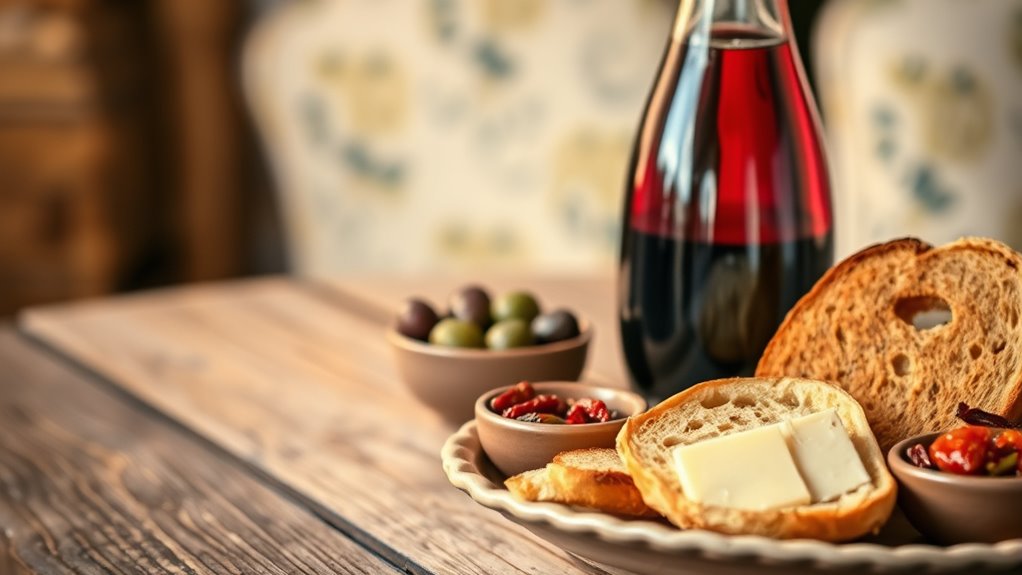
Pair crisp, mineral whites like Vermentino with seafood to create an invigorating contrast that highlights briny flavors. Its citrusy notes cut through oily seafood and saffron-infused dishes. Vermentino di Sardegna is known for its high acidity and fresh profile, making it ideal for seafood pairings. Match light, floral whites such as Nuragus with delicate fish or Caprese salad to amplify freshness without overpowering subtle flavors. This variety offers a gentle, aromatic profile that complements the nuanced flavors of light dishes. Combining tuning with subtle flavor profiles can subtly enhance the wine’s character and prevent overpowering the dish. Then, combine full-bodied reds like Cannonau with rich, fatty meats or aged cheeses to balance tannins and spice, enhancing savory qualities. Cannonau, made from Grenache grapes, is renowned for its robust flavor and refined tannins, which stand up well to hearty dishes. This approach elevates your pairing by emphasizing the natural harmony between land and sea, acidity and richness, ensuring each sip complements your dish’s character for a memorable experience.
Serving Tips to Maximize Your Sardinian Wine Experience
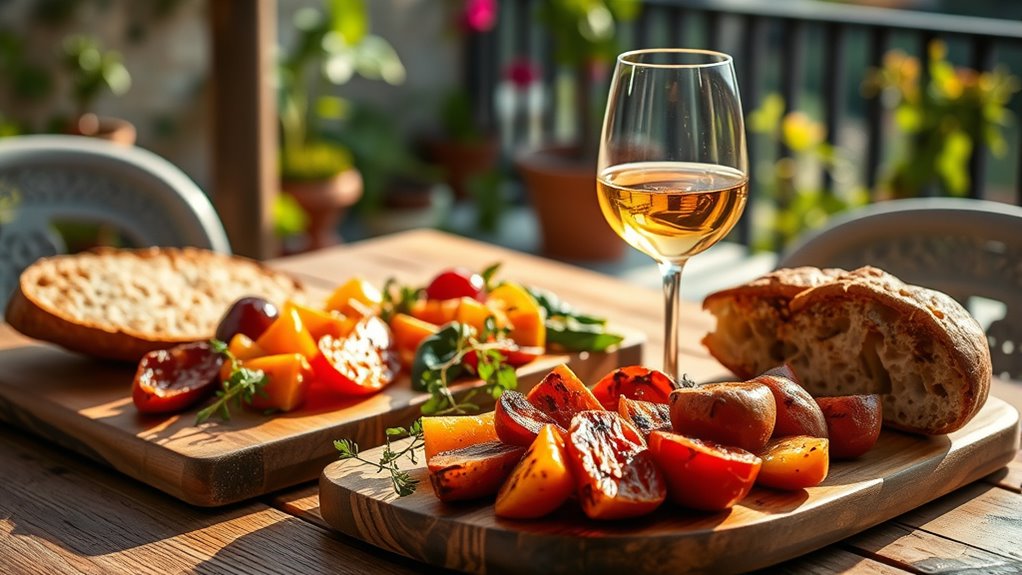
Optimizing your Sardinian wine experience starts with serving each glass at the right temperature. For whites like Vermentino and Nuragus, aim for 45-55°F (7-13°C) to keep their freshness and acidity vibrant. Reds such as Cannonau should be served slightly warmer, between 55-60°F (13-16°C), to enhance their flavor profiles. Sparkling wines like Spumante taste best chilled around 40-45°F (4-7°C) to maintain their effervescence. Use a wine thermometer to guarantee accuracy, and chill bottles in the fridge for 30-40 minutes if needed. Proper glassware also matters—smaller bowls preserve acidity in whites, while larger glasses for reds capture aroma. Handle and store wines carefully, keeping them in consistent, cool conditions, and always serve at the ideal temperature to fully enjoy their unique character. Maintaining optimal storage conditions is crucial for preserving wine quality over time. Additionally, understanding the lifestyle of wine consumption, including appropriate storage and serving techniques, can significantly enhance your overall experience.
Local Pairing Traditions and Creative Food-Wine Combinations

Sardinian food and wine traditions are deeply intertwined, reflecting the island’s coastal and pastoral heritage. You’ll find that local pairings often highlight contrasts and balance, creating memorable flavor combinations. For example:
- Vermentino’s acidity pairs beautifully with seafood like Fregola with clams, enhancing freshness.
- Cannonau’s robustness complements hearty inland dishes such as lamb or pork, adding depth.
- Innovative pairings like Monica di Sardegna with cured meats challenge expectations, blending richness and fruitiness.
- Considering the structure of wine, such as acidity and tannins, can further refine these pairings to suit different dishes and occasions. Understanding the food and wine pairing principles can help elevate the dining experience.
Regional traditions emphasize the use of native ingredients like bottarga and Pecorino cheese, anchoring pairings in history. Creative combinations, such as Nuragus with seafood linguine or Champagne with seafood, showcase how Sardinian wines adapt beyond traditional matches, elevating the culinary experience.
Frequently Asked Questions
Which Sardinian Wines Are Best for Vegetarian Dishes?
You’re wondering which Sardinian wines suit vegetarian dishes best. Vermentino and Nuragus are excellent choices, offering crisp acidity and herbal or floral notes that enhance salads and light veggie dishes. For heartier fare like legumes or roasted vegetables, try Briccone Caprera or a medium-bodied red like Cannonau. These wines balance flavors well, making your vegetarian meals more vibrant and enjoyable.
How Does Soil Type Influence Sardinian Wine Flavor Profiles?
You might not realize it, but soil types shape Sardinian wines more profoundly than the island’s rugged landscapes. Granite soils give wines a mineral brilliance, like a sparkling mountain stream. Limestone soils add elegance with acidity, like a delicate ballet dancer. Volcanic soils infuse wines with complex mineral notes, akin to a fiery volcanic eruption. Each soil type creates a distinct flavor profile, making Sardinian wines uniquely expressive of their terroir.
Can Sardinian Red Wines Be Paired With Spicy Foods?
You can definitely pair Sardinian red wines with spicy foods. For example, Cannonau’s moderate spice and balanced tannins work well with hearty, spicy meat dishes like lamb or wild boar stews. Monica di Sardegna’s bright acidity and fruity notes help soften milder spicy dishes or those with cheese. Just remember to choose wines with enough acidity and softer tannins to refresh your palate and avoid overwhelming the spice.
What Are the Ideal Serving Temperatures for Sardinian Fortified Wines?
Imagine pouring a glass of Vernaccia di Oristano after chilling it for 30 minutes—you notice its complex, nutty aroma come alive. For Sardinian fortified wines, aim for 57–62°F to highlight their oxidative and rich flavors. Lighter styles like Fino-style wines prefer the cooler end, while richer Madeiras perform better warmer, around 63–66°F. Using a thermometer helps guarantee you serve at the perfect temperature for maximum enjoyment.
Are There Traditional Sardinian Wine and Food Pairings for Special Occasions?
When planning a special occasion in Sardinia, you should match local wines with traditional dishes to elevate your experience. For example, serve Cannonau with roasted Porceddu or Sardinian sausage pasta, as their bold flavors complement each other. Pair Vermentino with seafood or Bottarga, and enjoy Cannonau Passito with berry tarts. These harmonious pairings highlight Sardinia’s rich culinary heritage, making your celebration truly authentic and memorable.
Conclusion
Now that you’ve uncovered the secrets of Sardinian wines and their perfect pairings, you’re ready to turn your table into a vibrant mosaic of flavors. Think of each sip as a brushstroke on a canvas, where food and wine dance in harmony like a well-rehearsed symphony. With your newfound knowledge, every meal becomes a voyage, revealing the island’s soul—rich, bold, and beautifully intertwined in a tapestry of taste.
